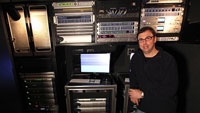Music Mix Mobile helps take Grammy audio to next level

The recent live CBS broadcast of the Grammy Awards from the Staples Center in Los Angeles featured a vast assemblage of artists, many doing special one-time arrangements — a daunting task for the audio engineering team. Airing just a week after the Super Bowl with its much-criticized music segments, it was clear that the telecast would be under the microscope.
“Frankly, it comes with the territory,” said Joel Singer, co-founder and chief engineer for Music Mix Mobile (M3), which supplied the music mix trucks for the broadcast. “To succeed in this kind of environment requires a lot of preparation. We give ourselves lots of advance time with two trucks on-site, recording, remixing and being able to revisit things. That gives us a great starting point for the telecast.”
The Grammy Awards are particularly challenging because The Recording Academy does not permit lip-synching.
“It’s a question that always gets asked and for this show, and the answer is always the same,” Singer stresses. “The show is totally live, with absolutely no tracked vocals. The Grammy people won’t have it any other way. The only exception is when there’s a doubled backing track lead vocal on the record. But everything coming off that stage is totally live; that’s part of the deal.”
Music mixers for this 5.1 surround broadcast were John Harris of M3 and Eric Schilling, co-chairman of The Recording Academy’s Producers and Engineers (P&E) Wing. Master audio was handled by A-1 Tom Holmes, all under the watchful eye of audio coordinator Michael Abbott. Additional hands on deck included Phil Ramone, audio producer for the show, and Hank Neuberger, audio supervisor, both of the NARAS P&E Wing. Mikael Stewart of ATK Audiotek, the show’s primary sound reinforcement provider, handled the broadcast mix. Dave Bellamy of Soundtronics was the wireless wrangler. This was Music Mix Mobile’s second year at the awards, but Singer and mixer John Harris have been involved since the ’90s.
For the M3 crew, the Grammy telecast starts early.
“Wednesday is engineering day,” Singer said. “We make all our connections to video world, set up the trucks, set up our preamps in the venue and start doing our configs. With 16 to 18 acts, you have to prebuild everything and populate plug-ins and effects routing to be ready for rehearsals.”
The professional video industry's #1 source for news, trends and product and tech information. Sign up below.
Both M3 trucks ran Pro Tools HD systems via 32-fader Avid D-Control surfaces. All audio, including three days of rehearsals, was recorded. Artist engineers were invited into the truck to provide input and approval of the mix, and the combination of Avid hardware and software along with the Waves Mercury software package provided the opportunity to perfect each mix as the week progressed. M3 also captured HD video so the artists could match details like panning to the performance.
“We do that for 12 or 13 hours a day and do all we can to make sure everyone on both the broadcast side and the artist side are satisfied,” Singer said. “Our infrastructure allows us to access any session from either truck, change plug-ins as needed, and tweak to your heart’s content. So everyone walks away from rehearsals happy. As long as the band comes on and plays it again the same way, we’re golden.”
After three long days of rehearsals, Sunday was the final step of the journey, starting with a final meeting that’s followed by a full dress rehearsal. At 5 p.m. PST, the three-hour-plus telecast went live.
“By 8:30 we’re done,” Singer said. “Everyone slaps each other on the back, we pop a big bottle of Diet Coke — since we don’t drink anymore — and we congratulate everyone. By 10:15, our trucks are rolling and we’re on our way home.”
The Music Mix Mobile infrastructure was all-digital, from preamps to monitor speakers. At the front end, 128 channels of Grace M802 preamps ensured pristine musical inputs and converted the audio to digital. The all-MADI system used RME I/O for the signal transport and MADI-xx routers by Chromatec, which contain built-in metering via a DVI port.
“That allows us to look at high-resolution meters for 128 channels across the board. It becomes a unique way for us to identify and see within a MADI data stream really quickly,” Singer said.
Within the M3 trucks, the audio remained in the digital domain all the way to the monitor speakers. On the broadcast side, the signal remained digital from the stage all the way to the CBS headend.
“If everything goes right, it comes to us digitally, goes to the television truck digitally, gets encoded digitally and never sees analog again until it comes out of your speakers at home,” Singer said.
The 5.1 monitoring system consisted of Genelec speakers, all with active DSP architecture and digital inputs. The L-C-R speakers were the 8250A, with a pair of 8240A monitors handling the rear left-right, and the subchannel used the Genelec 7260A. Thus, the audio signal literally remained in the digital domain until it reached the transducers themselves.
Microphones and wireless systems were selected based on the artists’ preferences and endorsements, filtered through the audio requirements of the broadcast.
“The mic and wireless complement is primarily Audio-Technica, Shure and Sennheiser,” Singer said. “The Grammy organization is committed to putting the artists in their comfort zone, which really allows them to focus on their performances.”
In addition to the live mixing of the program, M3 also recorded everything as three 56-channel stems, treating the entire week of rehearsals and the live telecast as a giant Pro Tools session that became property of The Recording Academy. Each truck housed four Mac Pro computers for this purpose.
“We’re a 100 percent Avid facility, currently running HD-8. We love the new Pro Tools 9, but we wouldn’t risk a show like the Grammys on a platform that we haven’t fully tested yet. We’re big believers in doing our homework,” Singer said.
Ironically, the audio team is among the last to really know how good the sound was.
“All I could tell you that night was that the technical side of things went great,” Singer said. “The wireless was rock solid; we didn’t hear a dropout all night, which is a real tribute to Dave Bellamy and Soundtronics. I knew that John Harris and Eric Schilling were happy, and that everything from 5.1 to the downmix worked perfectly. The only blemishes were profanity bleeps from CBS. But in terms of the music mix, the stars just seemed to align for us this year. Everyone was hitting on all cylinders, and we’ve gotten nothing but compliments.”
